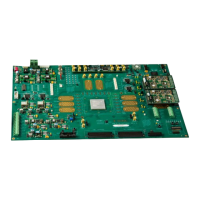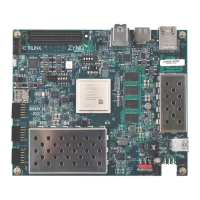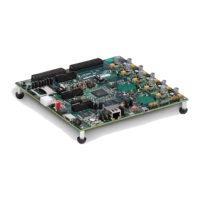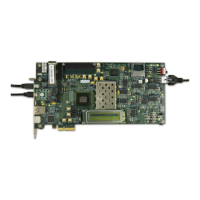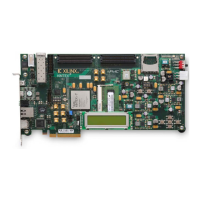Virtex-4 FPGA Configuration User Guide www.xilinx.com 61
UG071 (v1.12) June 2, 2017
Boundary-Scan for Virtex-4 Devices Using IEEE Standard 1149.1
Boundary-Scan Architecture
Virtex-4 device registers include all registers required by the IEEE 1149.1 Standard. In
addition to the standard registers, the family contains optional registers for simplified
testing and verification (Table 3-2).
Boundary-Scan Register
The test primary data register is the Boundary-Scan register. Boundary-Scan operation is
independent of individual IOB configurations. Each IOB, bonded or un-bonded, starts as
bidirectional with 3-state control. Later, it can be configured to be an input, output, or
3-state only. Therefore, three data register bits are provided per IOB (Figure 3-3).
When conducting a data register (DR) operation, the DR captures data in a parallel fashion
during the CAPTURE-DR state. The data is then shifted out and replaced by new data
during the SHIFT-DR state. For each bit of the DR, an update latch is used to hold the input
data stable during the next SHIFT-DR state. The data is then latched during the
UPDATE-DR state when TCK is Low. The internal DR CLK follows TCK when the TAP
controller is in the CAPTURE-DR state and SHIFT-DR state, however, it can toggle in other
states.
The update latch is opened each time the TAP controller enters the UPDATE-DR state. Care
is necessary when exercising an INTEST or EXTEST to ensure that the proper data has been
latched before exercising the command. This is typically accomplished by using the
SAMPLE/PRELOAD instruction.
Consider internal pull-up and pull-down resistors when developing test vectors for testing
opens and shorts. The Boundary-Scan mode determines whether the IOB has a pull-up
resistor. Figure 3-3 is a representation of Virtex-4 Boundary-Scan architecture.
Table 3-2: Virtex-4 JTAG Registers
Register Name Register Length Description
Boundary-Scan Register 3 bits per I/O
Controls and observes input,
output, and output enable.
Instruction Register 10 bits
Holds current instruction OPCODE
and captures internal device status.
Bypass Register 1 bit Device bypass.
Identification Register 32 bits Captures device ID.
JTAG Configuration Register 32 bits
Allows access to the configuration
bus when using the CFG_IN or
CFG_OUT instructions.
USERCODE Register 32 bits Captures user-programmable code.
User-Defined Registers
(USER1, USER2, USER3,
and USER4)
Design-specific Design-specific.

